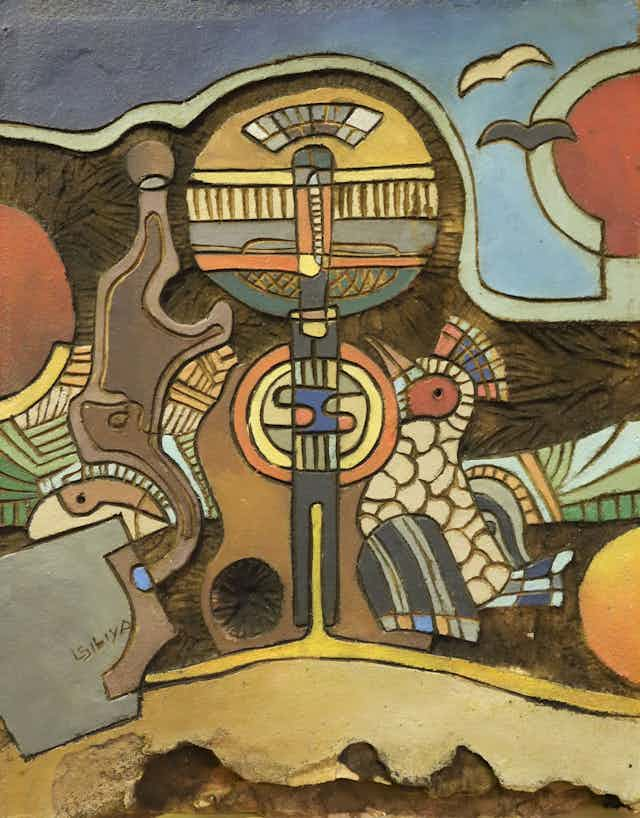The art world has been dealing with fakes for more than 2 000 years, with perhaps the most notorious case being the forgeries of Dutch master Johannes Vermeer’s paintings by artist Han van Meegeren during the Second World War.
Now African art is becoming a larger and larger target. Fakes are flooding the South African market and while a range of artists is affected, it’s mostly the black modernists (1960 - 1990) whose legacy is suffering.
To illustrate: If you use Google images to search for the work of Lucky Sibiya, the artist being used as part of a yet to be published study at the University of Pretoria, you’ll find that 30% of all the works yielded in the search are fakes. It’s the same with his contemporaries, among them George Pemba, Welcome Koboka, Nat Mokgosi, Martin Tose, Dumile Feni, Julian Motau and Eli Kobeli. They are just eight of a list of 21 artists identified as being forged.


The biggest reason fakers can get away with the deception is because there is not enough published source material on these artists. Six of the eight have no scholarly publications on them at all. So there are no references from the artists’ lifetimes to confirm the authorship of the works, even just stylistically.
An added factor is that their works generally sell for under R50 000. This means that sellers rarely take the time to do proper provenance research or to have the works technically analysed.
The growth in fake reproductions threatens the livelihood and reputation of artists. Once the work of an artist gets tainted as easily faked, demand dwindles. The consequence for those who have invested in art is also devastating.
Scientific research into art fakes is about much more than market value. It is about restoring some of the most important South African artists of past decades to a place of honour. Some seldom appear on auction as the art fraternity is too cautious to buy them.
Globally the faking of art is a very big problem as it is difficult to police and, with the internet, a crime that spans borders. The leading institution in researching fakes in the arts is the London-based Courtauld Institute of Art. However, a global initiative is lacking and uncovering fakes is mostly driven by auction houses and galleries.
The African Modernist fake school
So who is making and selling the fakes in South Africa?
Based on my research, I’m of the opinion that the bulk of the fakes we’ve studied can be traced to a group we call the African Modernist Fake School – a trained artist or group of artists working together to create fakes on demand. The demand is created by an equally well organised group of “galleries” and auction houses.

These auction houses hide behind small-print clauses like “signed as” and are mostly located in Johannesburg, Durban and Bloemfontein. For their part, the galleries exist only on the internet and use popular classified advertising and online auction sites to peddle their wares. The sellers often claim to have been friends with the artists and their families and may even have someone with the same surname as the artist on staff.
They sell fake works with made-up certificates of authenticity. Sometimes they publish books on the artists where fake works are mixed with originals to create a false provenance for the forgeries. One gallery went as far as donating fake works by black modernist artists to a university in the US.

But efforts are being made to stop the practice. Some credible auction houses are aware of the practice and call on universities such as ours if they’re suspicious of a work offered for sale.
At the University of Pretoria this year we introduced a Masters programme in Tangible Heritage Conservation. The purpose of the course is to train a cohort of conservators who are able to preserve and protect South Africa’s cultural heritage. The analytical techniques taught are put into practice by students investigating the materiality of artworks.
How to test for a fake
The investigation of an artwork starts with an in-depth documentation of the observed data; the painting’s title, date, signature, description, media, measurements, special physical characteristics and the like.
The investigation then moves into establishing a chain of ownership or possession. A direct line to the artist establishes the artwork’s authorship.

Then the signature is analysed, based on concepts of graphology. In Sibiya’s case one of the main differences between an original and a fake signature is the direction of the first “i” in Sibiya which the artist always painted from the base up and the forger from the top down.
The next step is to determine the colour palette. The artwork is then inspected under normal white light – often with the aid of a magnifier – to determine the surface characteristics of the artist’s technique. Substantiating information is obtained by using a high-powered USB microscope.

Next, ultraviolet-induced visible florescence means examining the work with a black light which makes different elements and materials fluoresce differently. Then an image is made of the artwork using visible light-induced reflected infrared photography. Different wavelengths of infrared help see below the painting’s surface.
The final technique is X-ray Fluorescent Spectroscopy to understand the materials and pigments that constitute the artwork.
This is still a relatively new field of inquiry in South Africa. As a result more expensive equipment is used on loan from US and German institutions.

While fake art is a global problem, the black South African modernists face a double exploitation because their work has not been given the attention it deserves. It should be a national imperative to shine a light on both their work and on those exploiting their legacy for financial gain.
The article draws on research being done by Salome le Roux, a masters student at the Univeristy of Pretoria.
This article has been updated to reflect legal concerns.

